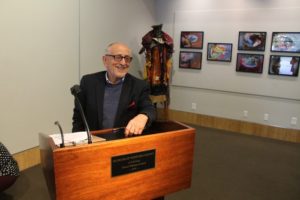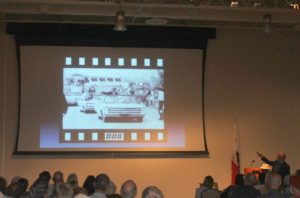
by Ivor Davis
The Museum of Ventura County, is a gem in downtown Ventura.
And happily more and more (still not enough) people are discovering the diverse pleasures of what the Museum has to offer.
Under the energetic guidance of executive director Elena Brokaw, program director Denise Sindelar, curator Anna Bermudez and a lively staff, the Museum has become re-energized revitalized—a delightful hotbed of art, history, culture, music, literature, fashion and so much more.
The other day I showed up at the Museum—and took the crowd of over 200 on what I can only describe as bizarre trip in time——back exactly 50 years!
That journey into the dark past to the mid-20th Century offered locals a glimpse a period in history that I fervently wish had never ever happened.
The destination was to the notorious kitchen of the Ambassador Hotel in Los Angeles where I saw what happened to presidential frontrunner Senator Robert Kennedy. That year “Bobby” was tipped to follow his late brother JFK into the White House. President Lyndon Baines Johnson had become something of a pariah as a result of his gross mishandling of the escalating Vietnam War, and had pulled out of the election.
 For America, 1968 was a memorable year—but for all the horribly wrong reasons: An unwinnable war, that had divided the nation and gun violence that destroyed the lives of two of the country’s most famous men, who offered hope, dramatic change, civil rights and a brighter more peaceful future.
For America, 1968 was a memorable year—but for all the horribly wrong reasons: An unwinnable war, that had divided the nation and gun violence that destroyed the lives of two of the country’s most famous men, who offered hope, dramatic change, civil rights and a brighter more peaceful future.
As I described seeing the wounded Robert Kennedy bleeding on the kitchen floor in the arms of his pregnant wife Ethel, there was total silence.
I was on the spot as a foreign correspondent for the London Daily Express assigned to cover Bobby’s Californian campaign.
As a speaker you always worry that you will show up—but no one else will. Fortunately it was a packed house with many having to stand at the back or sit on the floor. Others unfortunately, turned away for lack of seats.
My evening at the Museum was rewarding in a strange kind of way because many in the audience also wanted to take that sad journey back in time.
Museum librarian archivist and researcher Charles Johnson, had dug up a series of fascinating black and white photographs which showed Bobby and his pregnant wife Ethel campaigning in Ventura and Oxnard.
They were riveted by the series of black and white pictures of the campaigning Kennedy.
But what was most rewarding, was that in the audience we had an eclectic group. Ventura based Suzan Cooper, wife of one of the first astronauts Gordon “Gordie” Cooper whose husband had been very close to Bobby’s brother John. Richard Drescher, who was a young man working in the Kennedy campaign on the night he was shot. He told his own dramatic story of that fateful moment in history. Surfer Frank, from the Pierpont Racquet Club presented me with two old newspapers—which bore blazing headlines about Bobby’s death. And there were others, some mere children when Kennedy stopped off at the San Buenaventura Shopping Center and La Colonia in Oxnard. Their memories were vivid and so dramatic.
For me just their presence made my night at the Museum such a memorable one. And I hope the audience felt the same.
Editor’s note: Ivor Davis, a 38-year resident of Ventura is a former foreign correspondent and author of books about The Sharon Tate Murder, and a memoir entitled, “The Beatles and Me on Tour.”
